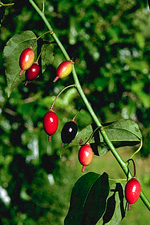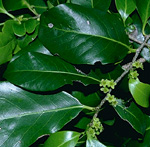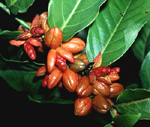 |
The family Flacourtiaceae are important in the tropics and parts of the Northern Hemisphere temperate zone. In Australia it is small and restricted to rain forests (including dry rain forest scrubs, littoral rain forest and montane subtropical rain forest) from southern coastal New South Wales to north Queensland.
Characteristic features of the family Flacourtiaceae in Australia include: - small trees, shrubs or twining climbers
- leaves alternate, simple, often with small glands or glandular teeth along the margins
- flowers small, regular, usually in axillary inflorescences, with 3-8 sepals and 3-many free petals, often with a prominent floral disc
- ovary superior; fruit a berry, drupe or capsule, often black or brightly coloured red or yellow
Description
Evergreen or semi-deciduous trees, or shrubs, or woody or herbaceous vines climbing by twining stems. Extra-floral nectaries absent or on the foliage. Internal secretions not obvious. Plants glabrous, or with simple or dendritic, non-glandular, uniseriate hairs. Leaves alternate, spiral or distichous, petiolate. Stipules distinct and free from petiole, scale-like, membranous or bristle-like, falling off early or persistent. Lamina simple, symmetric, lanceolate, ovate, elliptic, oblanceolate, obovate or oblong; base cuneate, attenuate, rounded or cordate; margins entire, crenate, dentate, serrate or spiny, ±flat; venation pinnate, with the midrib conspicuous, and the tertiary venation reticulate; surfaces punctate or not punctate; herbaceous or leathery. Domatia absent or consisting of pits, pockets or hair tufts in the vein angles. Male and female flowers occurring on separate plants, or with all the flowers bisexual. Inflorescences terminal, axillary, cauliflorous or ramiflorous, consisting of racemes, panicles, cymes or solitary flowers. Bracts and bracteoles present. Flowers odourless, fragrant or malodorous, stalked. Floral disc present or absent; nectaries present on the perianth or disc. Perianth regular, of 2 dissimilar whorls or of 1 whorl only or all whorls ±similar, with 2–24 segments, imbricate or valvate in bud. Calyx segments free or fused, with 2–12 sepals or lobes; calyx bell-shaped or funnel-shaped, herbaceous. Corolla segments free, with 2–12 petals, alternating with, or with no clear relationship to, the calyx segments, white, cream, orange, red, pink or green, without contrasting markings, membranous; claws absent; lobes ±entire. Fertile stamens 4–numerous, not clearly correlated with the sepals or calyx lobes, free of the corolla, free of the ovary and style, distinct from each other or grouped or fused into bundles, all ±equal. Staminodes present or absent. Anthers basifixed, not versatile, opening sideways by longitudinal slits, 2-celled. Ovary superior, sessile or part-inferior. Carpels 2–10, fused; ovary with 1–10 locules. Style terminal, single and unbranched, or branched above or from the base. Ovules 2–numerous per locule, stalked; placentation parietal. Fruit a dry, dehiscent septicidal capsule or a fleshy, indehiscent berry or drupe; the perianth on the maturing fruit deciduous, dry and persistent or growing larger. Disseminule macro-surface featureless or with straight hairs; micro-surface apparently smooth, yellow, orange, red, pink, green or brown, glossy or dull. Seeds 1–numerous per fruit. Aril present or absent. Cotyledons 2. Embryo straight.
(Note: this description has been generated from the coded data compiled for the key. Any errors in the key data will be reflected in the descriptions.)
A treatment of the family Flacourtiaceae has been published in:
Flora of Australia 8: 66-84.
Australian genera of Flacourtiaceae (as recognised for the Flora of Australia)
* = all species introduced
Baileyoxylon
Casearia
*Dovyalis
Flacourtia
Homalium
Oncoba
Ryparosa
Scolopia
Streptothamnus
Xylosma

|
  |

Berberidopsis beckleri (fruits)
Photo: G.Leiper © G.Leiper

Casearia costulata (fruits)
Photo: H.Nicholson © H. & N. Nicholson

Casearia multinervosa (flowers)
Photo: H.Nicholson © H. & N. Nicholson

Casearia sp. aff. dallachii (fruits)
Photo: G.Sankowski © Zodiac Publications

|
 |
|